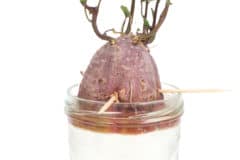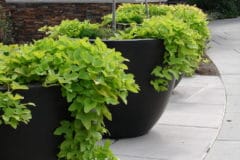How To Grow Sweet Potatoes
Sweet potatoes are tropical plants that typically do well in USDA Zones 8 and 9. With careful planning and season extending techniques, you may also be able to grow them in colder zones and still get a decent harvest. Not really fussy about soil, they’ll produce better if the soil is rich and loose so it drains well. Regular water – especially in dry areas – helps ensure a better crop.
Sweet Potato Varieties
Jewel is probably the classic sweet potato, with copper skin and bright orange flesh. But these are also available:
- Beauregard – colored like Jewel; common commercial variety
- Envy – mild taste, pale orange skin and flesh
- Garnet – purple-red skin, moist orange flesh
- Hannah – tan skin, off-white interior
- Stokes Purple – purple all the way through.
Choosing Tubers for Slips
Sweet potato tubers will not begin to break dormancy until spring. Tubers of any sweet potato variety can be used to start slips. Choose a tuber that looks firm and plump, not shriveled. Avoid any that have nicks or cuts, as the wound may mean the tuber has been infected with bacteria. Also avoid any that have blackened or gray areas that might indicate mold or other diseases.
Timing Matters
You should expect that it will take about six weeks for your slips to sprout and be ready for planting. Sweet potatoes are very frost-sensitive, so you shouldn’t plant them until at least two and preferably four weeks after your last expected frost date. It’s best to err on the side of caution, and start your slip-growing process about eight weeks before the last expected frost date.
Starting the Slips
In addition to the tuber, you need a glass jar and some toothpicks – the sturdy kind that are round and thicker in the middle. Fill the jar – a pint canning jar is a good choice – three-quarters full of water. Insert toothpicks around the middle of the sweet potato so the water level comes up about three inches on the bottom (pointed) half. Place the jar in a sunny window.
Growing the Slips
Most sweet potatoes will start to sprout almost immediately if they have been dormant long enough. You can expect to see rootlets within two to four days. The jar will quickly become filled with roots. Change the water every few days so it doesn’t become stagnant. Sprouts will usually appear within a week or so.
Removing the Slips
Once the slips are about five or six inches long – usually about three or four weeks after you start the potato – you can remove them. Grasp a sprout near the base and pull it loose; it will leave a small hole. Place all the sprouts in another glass jar or jars and put them in a sunny place. In most cases, they will be ready to plant in about two more weeks.
Growing On
Once you are sure it’s warm enough, you can plant your slips you have been growing. Dig a trench or individual holes. You want the slips at the same depth as they were in the pot, or up to one inch deeper. Space the slips about 18 to 24 inches apart in the garden. Tip the pot and give it a sharp rap on the bottom; the plant will slide right and can be set in the soil. Firm dirt over the roots and water well.
Sweet Potatoes Indoors
Sweet potato slips grow so readily that it’s easy to treat them like houseplants and keep them growing indoors. Prepare the sweet potato as described above. You might want to use a larger jar or container so the roots have room. Place the container in a sunny place and change water every week or so. You can enjoy as a houseplant or harvest the edible leaves and cook them as you would greens like kale or spinach.
Slips for Hanging Baskets
Sweet potatoes make attractive hanging baskets due to their vining nature. They look lush and tropical on a patio or deck. Line a metal basket with sphagnum moss, then fill with potting soil. Plant the slips in the soil as you would if potting them. Hanging baskets can dry out quickly, so check frequently and water as needed. You probably won’t get any tubers from these baskets.












